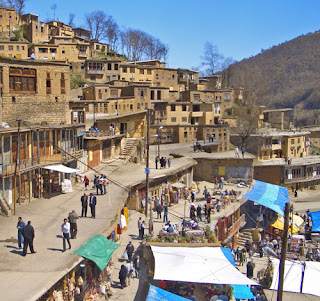Iranian reactions to the movie 300
Iran's mission to the UN has issued a statement criticising the movie "300", calling it "a thinly-veiled attack on Iranian history." The full text was published on Irna news.
The statement expresses what many Iranians feel about a film that most haven't even seen yet - that misrepresentations of Iran in Western media are something close to a deliberate campaign to present Iran as "a dangerous, bestial force fatally threatening the civilized 'free' world." Government Spokesman, Gholam Hossein Elham, described it as a "cultural intrusion" and said the government interpreted it as "hostile".
I was at a talk held at the Khaneye Honarmandan artists centre where a mercifully edited version of "300" was shown to an audience mainly of university students. Listening to the talk that followed, I was struck with just how intensely felt, yet deeply vulnerable, the Iranian sense of national identity was.
During the screening the mood was light. When King Khashayarshah (Xerxes), a three-metre-tall drag queen, stepped-off his medieval hovercraft, the audience laughed along with Leonidas' raised eyebrow. The anticlimactic end of the Persian attack rhinoceros was another amusing highlight. I noticed a number of other representations that could be interpreted as more serious insults. For me, the ape-like masks of the "eternal warriors" sent a potentially racist message. Furthermore, referring to the Persian army as "slaves" belies the historical truth that the Persian Empire was, unlike Greece, Rome and Egypt, not dependent on slavery.
Iranians live under a persistent irony. Their country's
glorious past casts a long shadow over the Iran of modern times. Every Iranian will relate with pride and confidence in the historical facts that the Iranian empire was the first and largest of ancient times and, at its height, stretched from Greece to China. They cite great leaders whose names were suffixed with "the Great" as rulers with enlightened ways who led their people with intelligence and fairness. What's more, every time foreign powers invaded Iran, either the invaders themselves effectively became Iranians (
Mongols,
Turks) or Iranian culture simply resurfaced in new forms to absorb the invading culture (
Arabs).
But far from blaming westerners for not accurately representing an ancient civilization to which they owe such a huge debt, the Iranians in the audience expressed a deeply self-critical attitude. One woman asked why so few of her countrymen and women attended a protest against a dam-building project which was set to submerge an important archaeological site. Another hit on another very deep vein of dissatisfaction citing many examples of how Iran's pre-Islamic history was being downplayed. Why, for instance, were there no roads named after Kouroush (Cyrus the Great) while so many were named after clerics made famous by the Islamic revolution or Iran-Iraq war. When the current of discussion threatened to break out into open criticism of the government, the chairman had to reign it in. He mentioned that, if the attendees appreciated the facilities provided by the Khane Honarmandan, it would be advisable not to turn it into a base for political debate.
A more lighthearted response to the film comes from Iran's best known satirical cartoonist, Touka Neyestani. Thanks to Zeynab's sister for the following translation:
I simply don't understand why my Iranian friends were upset by this film. After all, it's not the first time that Hollywood has done this. It has been doing it to Native Americans, blacks, Arabs, Germans, Japanese,... etc for years. Just last year we all saw "Borat" and we all laughed.
© Iranvisitor.com












 Born in Iran, the 43-year-old left his homeland for America in 1977 and went to the 1998 World Cup with the United States and the 2002 and 2006 World Cups with South Korea.
Born in Iran, the 43-year-old left his homeland for America in 1977 and went to the 1998 World Cup with the United States and the 2002 and 2006 World Cups with South Korea.



















